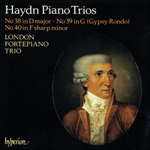
Welcome to Hyperion Records, a British classical label devoted to presenting high-quality recordings of music of all styles and from all periods from the twelfth century to the twenty-first.
Hyperion offers both CDs, and downloads in a number of formats. The site is also available in several languages.
Please use the dropdown buttons to set your preferred options, or use the checkbox to accept the defaults.

| London Fortepiano Trio» More |
Among Haydn’s later trios, the Piano Trio in D major Hob XV:24 is unusual in being consistently serious in tone, with almost Beethoven-like earnestness. The first movement is on quite a large scale, full of pauses and surprises, sudden offbeat accents and bursts of energy—just the effects that Beethoven was beginning to exploit. The writing for piano makes full use of the English grand pianos Haydn had got to know, with rich chords, bold octaves in the bass and much brilliant elaboration above. The brief second movement is built from an anxious little dotted-rhythm figure, which has the air of a solemn dance. It leads without a break into the finale. This looks, on paper, somewhat like a minuet. But the triple-time is continually disguised and subverted by the interplay between the instruments, and by successions of phrases two beats long. The overall impression is less of a dance and more of a rather worried conversation, which finally comes to an unexpected end as if the speakers had walked off through the door, still talking.
from notes by Robert Philip © 2009
Le Trio avec piano en ré majeur Hob XV:24 se démarque des trios haydniens tardifs par son ton constamment sérieux, d’une gravité quasi beethovénienne. Le premier mouvement, d’envergure, est bourré de pauses et de surprises, de brusques accents anacroustiques et de bouffées d’énergie—les effets mêmes que Beethoven commençait d’exploiter. L’écriture pianistique utilise pleinement les pianos à queue anglais, avec de riches accords, de vigoureuses octaves à la basse et avec, par-dessus, beaucoup de développement brillant. Le second mouvement repose sur une angoissante petite figure en rythme pointé, aux allures de danse solennelle, et débouche directement dans le finale. Sur le papier, on dirait un peu un menuet. Mais la mesure ternaire est constamment travestie, subvertie par le jeu entre les instruments et par des phrases de deux temps. L’impression globale est moins celle d’une danse que d’une conversation plutôt inquiète, à la fin inattendue, comme si les locuteurs étaient sortis par la porte sans s’arrêter de causer.
extrait des notes rédigées par Robert Philip © 2009
Français: Hypérion
Unter Haydns späteren Trios ist das Klaviertrio in D-Dur Hob XV:24 insofern ungewöhnlich, als es durchweg seriös im Ton bleibt—mit einer nahezu beethovenhaften Ernsthaftigkeit. Der erste Satz ist relativ groß angelegt, voller Fermaten und Überraschungen, plötzlicher synkopierter Akzente und Energieausbrüche—genau wie die Effekte, die Beethoven auszunutzen begonnen hatte. Der Klaviersatz nutzt die Möglichkeiten der englischen Flügel, die Haydn kennen gelernt hatte, voll aus: mit sonoren Akkorden, kraftvollen Oktaven im Bass und zahlreichen Verzierungen über ihnen. Der knappe zweite Satz wird aus einer beklommenen kleinen rhythmischen Figur konstruiert, und besitzt den Charakter eines feierlichen Tanzes. Er geht direkt ins Finale über. Auf dem Papier ähnelt dies einem Menuett, aber der Dreiertakt wird stetig verschleiert und durch das Wechselspiel zwischen den Instrumenten und einer Folge von Phrasen subvertiert, die zwei Taktschläge lang sind. Der Gesamteindruck ist weniger der eines Tanzes sondern eher der einer ängstlichen Konversation, die schließlich unerwartet endet, als ob die Redner, noch im Gespräch, aus der Tür gingen.
aus dem Begleittext von Robert Philip © 2009
Deutsch: Renate Wendel
 Haydn: Piano Trios Nos 38-40 Haydn: Piano Trios Nos 38-40‘The London Fortepiano Trio play these delightful works with style and panache’ (Hi-Fi News)» More |

